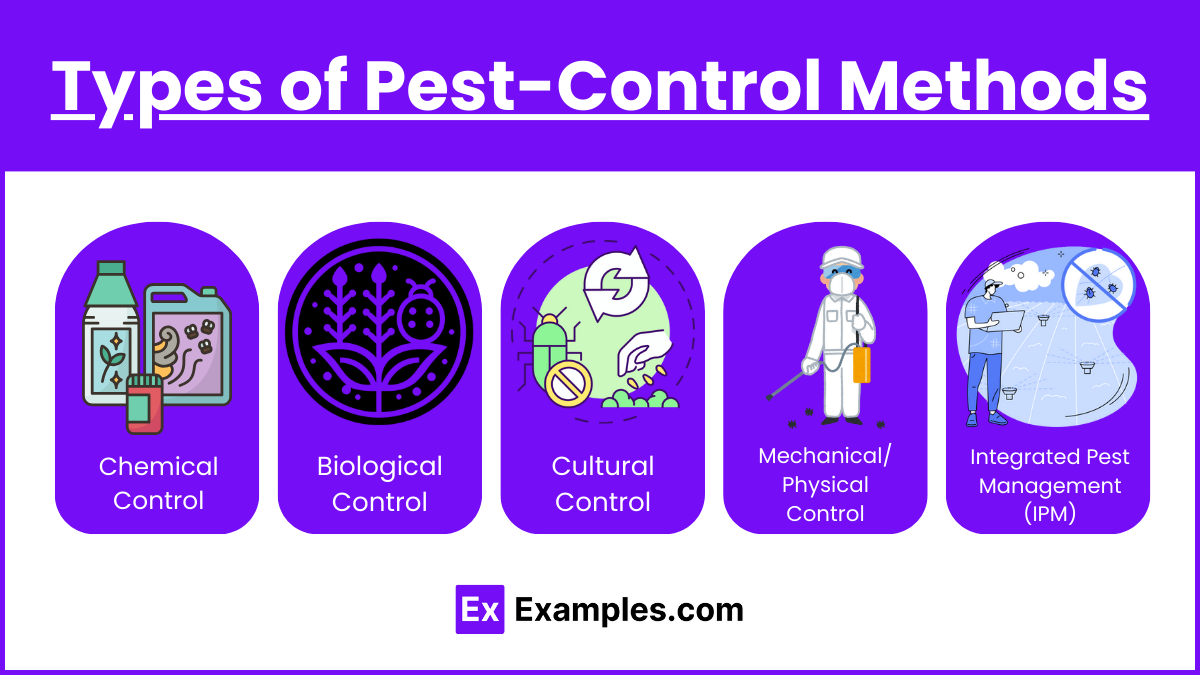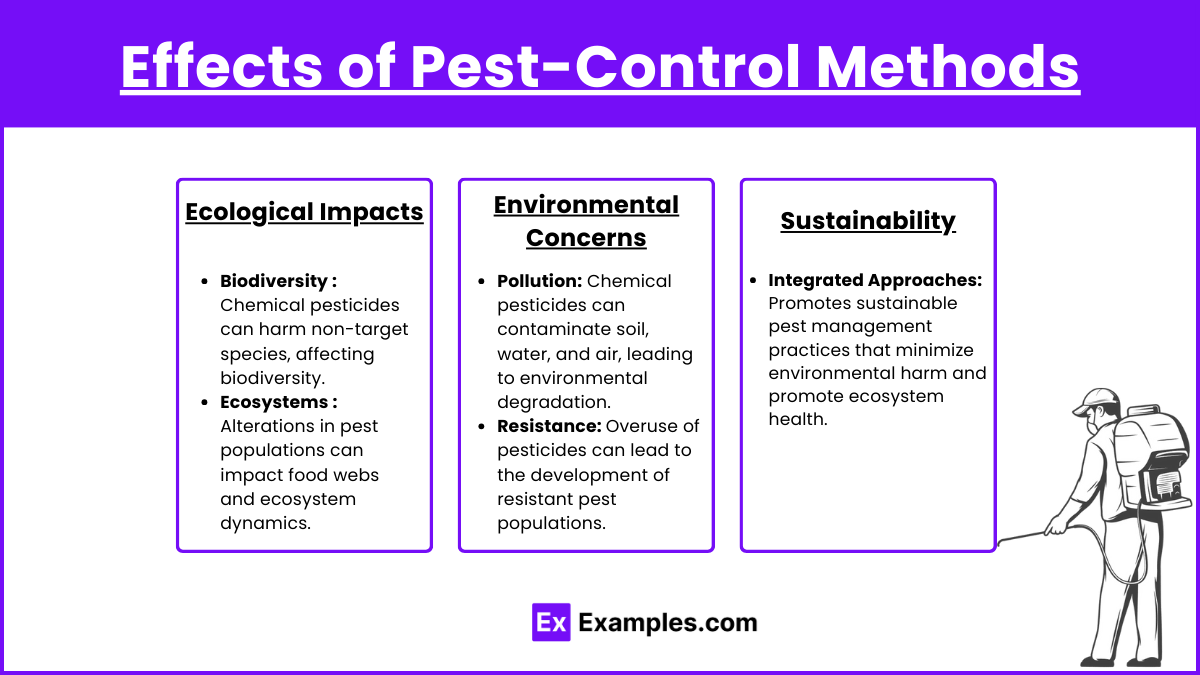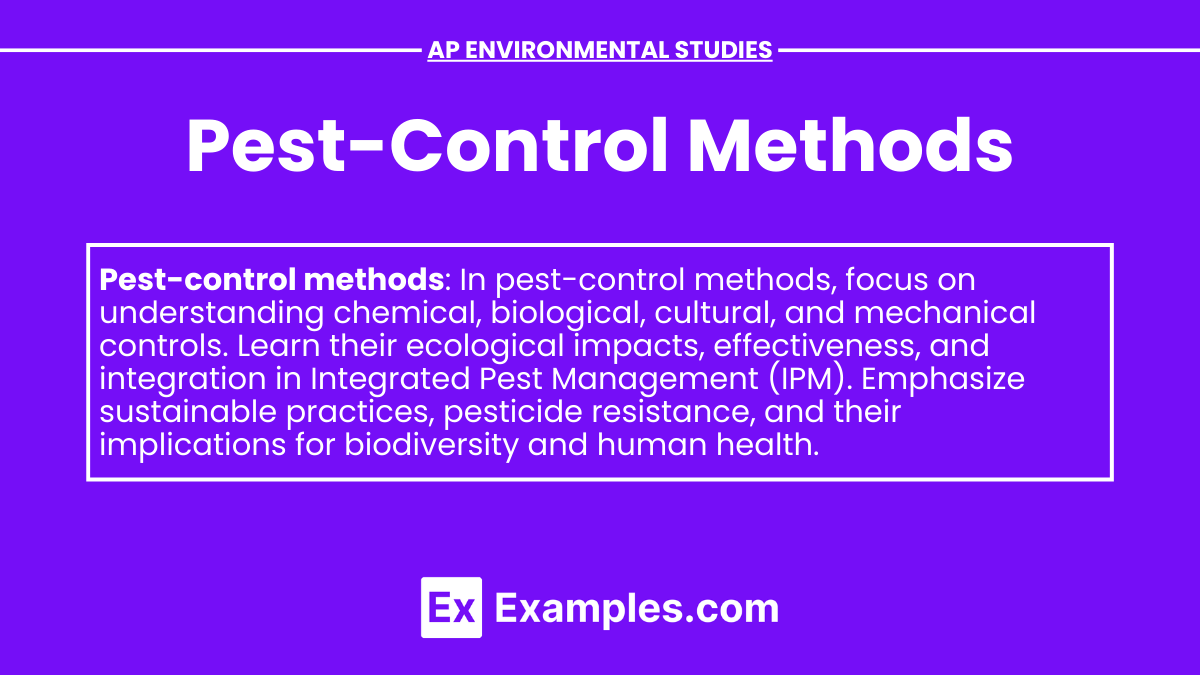Pest-control methods are essential for managing agricultural pests and ensuring crop productivity, significantly influencing ecology and ecosystems. These methods range from chemical pesticides to biological control and integrated pest management (IPM), each with varying impacts on biodiversity and the biosphere. Chemical pesticides can lead to pollution and non-target species harm, while biological control promotes natural predator-prey relationships. Understanding these methods and their ecological effects is crucial for AP Environmental Studies students to foster sustainable and environmentally friendly pest management practices.
Learning Objective
The learning objectives for pest-control methods include understanding various techniques and their impacts on organisms, climate changes, and flora and fauna. Students should explore chemical, biological, and integrated pest management (IPM) approaches, analyzing their effectiveness and environmental consequences. They need to evaluate how pest-control practices affect ecosystems, biodiversity, and non-target organisms, and assess the role of pest management in adapting to climate changes. Emphasis will be on promoting sustainable methods that protect flora and fauna while ensuring agricultural productivity.
Types of Pest-Control Methods

- Chemical Control
- Description: Involves the use of synthetic or organic pesticides to kill or repel pests.
- Examples: Insecticides, herbicides, fungicides.
- Advantages: Effective at reducing pest populations, quick results.
- Disadvantages: Potential harm to non-target species, environmental pollution, development of pesticide resistance.
- Biological Control
- Description: Uses natural predators, parasites, or pathogens to control pest populations.
- Examples: Ladybugs for aphid control, Bacillus thuringiensis (Bt) for caterpillars.
- Advantages: Target-specific, minimal environmental impact, sustainable.
- Disadvantages: Slow to establish, effectiveness may vary with environmental conditions.
- Cultural Control
- Description: Practices that alter the environment to reduce pest populations.
- Examples: Crop rotation, planting resistant varieties, adjusting planting dates.
- Advantages: Long-term pest management, reduces reliance on chemicals.
- Disadvantages: Requires knowledge and planning, may not eliminate pests completely.
- Mechanical/Physical Control
- Description: Uses physical barriers or traps to prevent pests from accessing crops.
- Examples: Row covers, traps, barriers.
- Advantages: Non-chemical, reduces pesticide use, can be cost-effective.
- Disadvantages: Labor-intensive, may not be suitable for large-scale operations.
- Integrated Pest Management (IPM)
- Description: Combines multiple pest-control methods in a coordinated manner.
- Components: Monitoring pests, using thresholds for intervention, employing a combination of biological, cultural, and chemical controls.
- Advantages: Minimizes environmental impact, sustainable, reduces pesticide resistance.
- Disadvantages: Requires expertise and ongoing monitoring, initial setup costs.
Effects of Pest-Control Methods

- Ecological Impacts
- Biodiversity: Chemical pesticides can harm non-target species, affecting biodiversity.
- Ecosystems: Alterations in pest populations can impact food webs and ecosystem dynamics.
- Environmental Concerns
- Pollution: Chemical pesticides can contaminate soil, water, and air, leading to environmental degradation.
- Resistance: Overuse of pesticides can lead to the development of resistant pest populations.
- Sustainability
- Integrated Approaches: Promotes sustainable pest management practices that minimize environmental harm and promote ecosystem health.
Case Studies
- Diversity in Agriculture
- Example: Organic farming emphasizes biological and cultural pest-control methods to reduce reliance on chemicals.
- IPM Implementation
- Example: California’s citrus industry uses IPM to manage pests like the Asian citrus psyllid while minimizing environmental impact.
Future Directions
- Advancing Technology
- Biotechnology: Developing pest-resistant crop varieties through genetic engineering.
- Precision Agriculture: Using data and technology for targeted pest-control interventions.
- Policy and Education
- Regulations: Implementing policies to reduce pesticide use and promote sustainable pest management practices.
- Education: Training farmers and agricultural professionals in IPM techniques and environmental stewardship.


